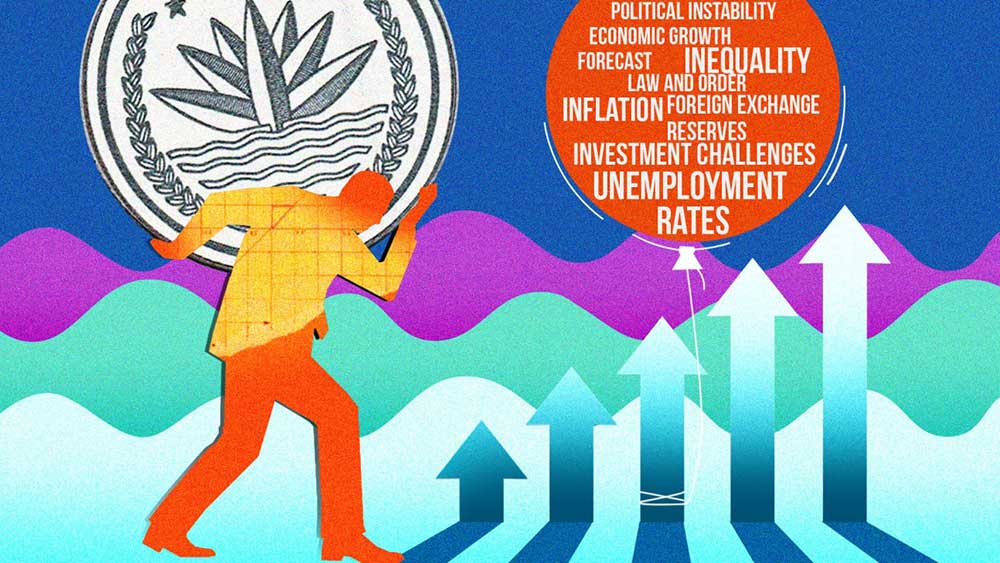Originally posted in The Daily Star on 15 October 2024
 Bangladesh’s economy has been under tremendous pressure for over two years. The previous government (that was ousted), led by Sheikh Hasina, left behind a fragile economy marked by high inflation, low foreign exchange reserves, rising debt, high fuel prices, poor tax collection, low investment, a high rate of loan defaults, unemployment, inequality, and other challenges.
Bangladesh’s economy has been under tremendous pressure for over two years. The previous government (that was ousted), led by Sheikh Hasina, left behind a fragile economy marked by high inflation, low foreign exchange reserves, rising debt, high fuel prices, poor tax collection, low investment, a high rate of loan defaults, unemployment, inequality, and other challenges.
The mass movement in July and August 2024 had not only resulted in the tragic death of hundreds and severe injuries to thousands, but also subdued economic activity. The industrial and service sectors experienced losses, though the agricultural sector remained largely unaffected during this period. Soon after the new interim government took office, parts of eastern Bangladesh were flooded due to heavy rainfall and water from upstream sources, causing severe damage to lives and livelihoods in 11 districts. The cost of the damage was estimated at Tk 14,421 crores, equivalent to 0.26 percent of the projected Gross Domestic Product (GDP) for the fiscal year 2025, according to the Bangladesh Bureau of Statistics. This estimation includes the agriculture and forestry, infrastructure, housing, health, education, and industrial sectors. It is estimated that until August 30, 54 people had died, and 5.4 million were affected by the floods in those districts. Unfortunately, before the water could fully recede, several northern districts were also struck by floods.

Following the success of the student-led mass uprising, the country’s law and order deteriorated as the police were largely absent from performing their duties. The interim government has been working to improve the situation by granting the military magistracy powers, but law and order has yet to be fully restored. This has raised concerns not only for ordinary citizens but also for potential domestic and foreign investors interested in Bangladesh.
The government has launched several reforms aimed at strengthening institutions and improving the political and economic conditions of the country. The Bangladesh Bank has formed task forces to improve the banking sector, and the planning ministry has formed a taskforce called “Re-strategising the economy and mobilising resources for equitable and sustainable development.” The chief adviser has established six commissions to reform key areas, including the constitution, public administration, the Anti-Corruption Commission, the judiciary, the police, and the electoral system.
One of the main demands of the July movement was for a country free from discrimination and injustice, and the people of Bangladesh are eagerly awaiting the recommendations of these reform initiatives. Of course, neither the interim government nor the next elected government has a “magic wand” to fix the deeply entrenched socio-economic and political problems that have developed under years of corruption and exploitation. Implementing the necessary reforms will take time as the best rules need to be practised and absorbed over time before the ideal situation that the students and mass people dreamt of can truly be observed.
However, in the short term, restoring law and order and resuming economic activities are the government’s most important tasks. Controlling high inflation and ensuring businesses and the economy are functioning properly are crucial to recouping economic losses and maintaining growth.
Recently, in its South Asia Development Update released in October 2024, the World Bank revised its economic growth forecast for Bangladesh, lowering it to four percent for FY2025, down from an earlier estimate of 5.7 percent in April 2024. This represents a sharp decline, marking the lowest growth estimate in several years, except for 2020, which was affected by Covid—when Bangladesh experienced a growth rate of 3.5 percent. Unfortunately, while South Asia is projected to be the fastest-growing region globally, with a growth forecast of 6.4 percent, Bangladesh’s economic outlook has worsened.
The revised growth projection for Bangladesh sends three key messages to policymakers. First, uncertainties due to political turmoil have affected the confidence of both domestic and international economic players regarding the country’s economic prospects, despite its huge potential—reducing private investment and slowing industrial growth. Second, lower growth will further diminish the purchasing power of ordinary citizens, as their incomes will not increase while inflation continues to soar. The Bangladesh Bank’s contractionary monetary policy is not working due to rent-seeking and syndication in the market. With agriculture being affected due to the ongoing floods in the country, prices are likely to increase further. Third, economic indicators, including growth numbers, will have to be realistically estimated to ensure they are seen as credible and reliable. The World Bank’s estimate stands in stark contrast to the previous government’s projection of 6.8 percent growth for FY2025. The Centre for Policy Dialogue (CPD) has long highlighted the issue of unrealistic growth projections in the absence of private investment and macroeconomic stability.
In view of the subdued economic prospects, the interim government needs to work hard towards addressing the immediate issues in overcoming the uncertainty and providing respite to common people by containing inflation, while preparing for the medium-term issues through reform measures. Unlocking the untapped potential of human resources—including that of women—through quality education and skills development, is crucial for driving economic growth going forward. The government’s ability to navigate these challenges will determine whether Bangladesh can achieve sustainable and inclusive growth.
Dr Fahmida Khatun is the executive director at the Centre for Policy Dialogue and non-resident senior fellow of the Atlantic Council. Views expressed in the article are the author’s own.



